LG’s new rollable OLED 65-inch TV with an 8K screen will cost a staggering $87,000 (around £67,000), the tech firm has revealed.
The Signature OLED R, which descends into an aluminium base when not in use and takes up a ‘minimal amount of real estate’, is now available in South Korea.
Manufactured in LG’s Gumi facility, each TV is painstakingly assembled ‘with craftsman-like skill with attention to every detail’, LG said.
The firm called the TV an ‘exquisite creation’ and ‘a work of art that will enhance any space and complement any lifestyle’.
LG announced the launch of the world’s first rollable TV, the LG Signature OLED R for $87,000
LG is displaying the TV at seven premium consumer electronics stores located in major retail centres throughout its home country.
It’s only available in South Korea for now but LG aims to bring it to other countries in the future.
‘The seamless marriage of technological and design innovation demonstrated in LG Signature OLED R is an unprecedented feat that genuinely deserves to be called a work of art,’ said Park Hyoung-sei, president of LG Home Entertainment Company.
‘This is a true luxury product that reimagines what television can be.’
LG admitted that the TV is ‘the very definition of exclusive’ and it’s likely the price-tag will turn off all but the most wealthy of buyers.
Signature OLED R, which was originally unveiled more than two years ago at the Consumer Electronics Show 2018, lets its owners ‘curate their living environment’.
Owners have more freedom as to where the device can go due to its roll away ability.
The design aims to optimise space, allowing the large screen to be packed away in a more compact form when it’s not in use.
Users can choose from three modes – full view, line view and and zero view.

The high-end device gives users the freedom that a projector offers by dispensing of the big black screen that may be an eyesore when not in use

At a mind-melting $87,000, the device may only appeal to millionaires and corporate organisations

LG said: ‘Not just an exceptional feat of engineering and user-centric design, this TV is a work of art that will enhance any space and complement any lifestyle’

Users can choose from three modes – full view, line view and and zero view In full view, the TV rolls out to show the whole 65-inch display

In line view, the TV screen disappears partially to reveal a dashboard showing the weather and other daily updates

In zero view, the TV screen disappears completely to hide inside a base that’s essentially a massive speaker
In full view, the TV rolls out to show the whole 65-inch display, in line view it is partially unrolled and in zero view the screen disappears and hides inside a base that is essentially a massive speaker.
‘Line view allows the LG Signature OLED TV R to be partially unrolled, allowing for management of specific tasks that do not require the full TV screen,’ LG said.
‘Even in zero view, users can enjoy music and other audio content which resonate from the 4.2-channel, 100W front-firing Dolby Atmos audio system.’
Customers can have their choice of four shades of covering – ‘signature black’, ‘moon grey’, ‘topaz blue’ or ‘toffee brown’ – and personalise their unit with an engraving of a name or message on the aluminium base.
The TV is also supported by Amazon’s Alexa voice assistant – users just hold down the Prime Video button on the remote to activate Alexa and switch channels, search for content and perform other commands.
The TV’s OLED (organic light remitting diode) display features self-lit pixel technology, meaning each pixel in the TV works independently to emit its own light.

